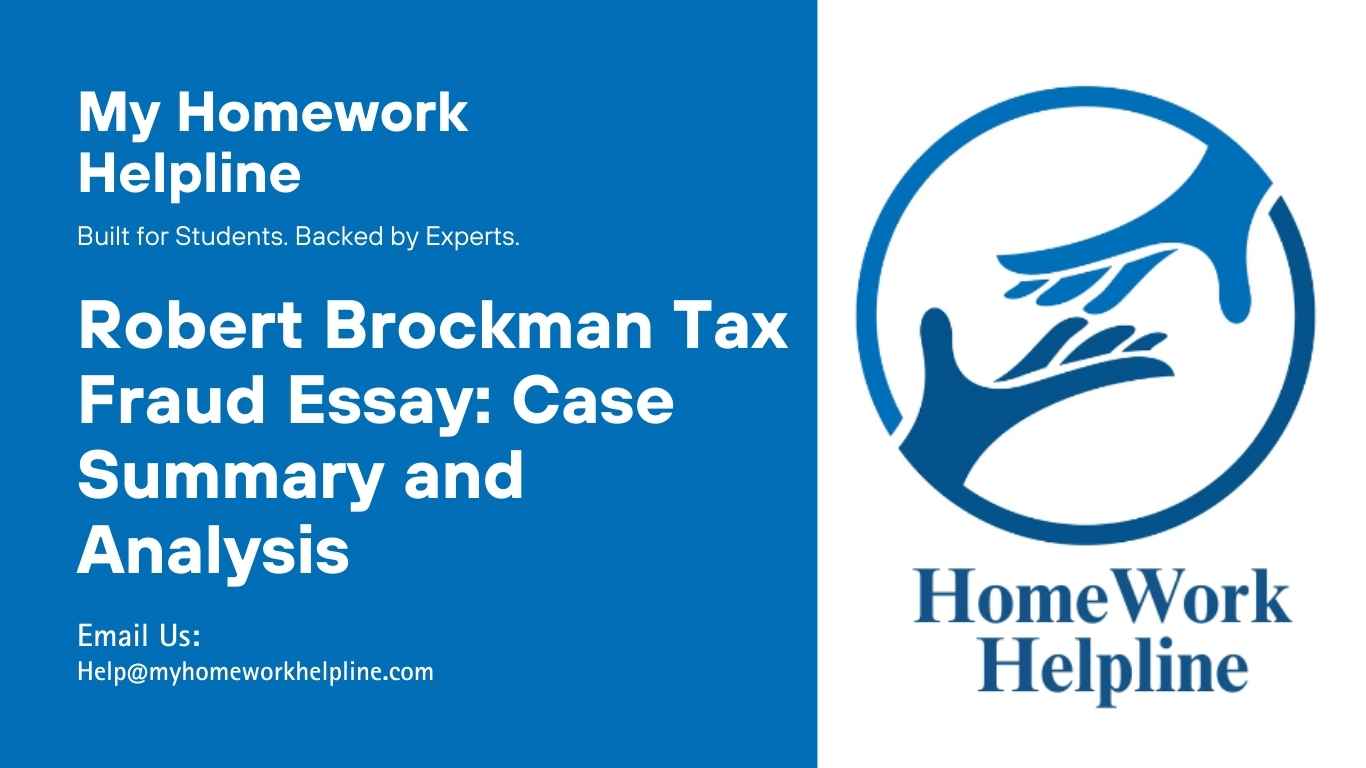Robert Brockman Tax Fraud Essay: Case Analysis and CPA Responsibilities
Case Summary
According to Zagaris (2020), Reynolds and Reynolds C.E.O. Robert T. Brockman was charged in 2020 for tax evasion due to hiding income of over $2 billion from the Internal Revenue Service (IRS). This income earned from his private equity investments was hidden in offshore entities in Bermuda and Nevis. Brockman’s indictment includes 39 counts comprising tax evasion, lack of filing overseas bank account statements, wire fraud, concealing money laundering, evidence altering, and destroying evidence, to which Brockman pleaded not guilty. His prosecution was aided by Robert F. Smith’s collaboration with the Justice Department by signing a Non-Prosecution Agreement (NPA). Robert F. Smith cooperated with Brockman in various tax evasion cases where they used offshore bank accounts and failed to report over $200 million in partnership income. The NPA required Smith to cooperate with the Justice Department on related investigations for five years and pay taxes and penalties of over $139 million.
Working on essays or assignments about tax fraud, financial crimes, or CPA responsibilities can be complex. Our expert team provides detailed guidance and homework assistance to help you analyze cases like Robert Brockman’s $2 billion tax evasion. With professional support, you can structure your essay accurately, highlight key issues, and strengthen your arguments. Check out our accounting homework helpline to get expert essay support today.
Issues that Led to Tax Fraud
Multiple issues led to the tax fraud, including that Brockman had backdated records to execute the fraud. In addition, he encrypted and coded his messages when communicating with a co-conspirator in the fraud. The backdated records and encrypted communications made it difficult for the IRS to track or be aware of any fraud being committed. Furthermore, Brockman often used a third party to commit tax fraud. For example, he used one in a deceitful arrangement to gain over $67 million in his work company debt securities. As the company’s CEO, his work agreements prevented him from purchasing the debt securities without early notice, complete disclosure, and amendments of the involved credit contracts. Thus, he used a third party to obtain the debt securities and hide important economic information from sellers, which led to tax fraud. Brockman also did not want the IRS to know of his capital gains income from investing in Vista Equity Partners, headed by Robert F. Smith, who had started the company on Brockman’s behalf. Therefore, Brockman’s use of third parties made it easier for him to evade tax and commit tax fraud.
C.P.A.’s Culpability in Fraud Cases
Because CPAs handle their clients’ financial records to prepare tax returns, they easily get blamed for criminal taxation issues. However, a CPA is responsible for a client’s tax fraud when they willfully create and subscribe to a document or statement verified by a written declaration that they do not believe true or correct (Schlesser, 2011). CPAs are also responsible for fraud cases when they willfully assist or advise the preparation of a fraudulent document under internal revenue laws. It does not matter whether the CPA knows or not that the document is fraudulent as long as they oversee its preparation and presentation. A CPA is also guilty when they conceal a property that needs to be levied, intending to evade tax collection on the property.
CPAs can be charged with crimes due to their roles, including aiding and abetting, presenting a false or fraudulent claim to the government, and conspiring with their client to commit fraud. However, a CPA may not be held responsible for a client’s tax fraud when they come across a previously erroneously filed document and advice on the best corrective measure to undertake. The CPA would only report the tax authority on the erroneous document after getting permission from the client or when required by law (Schlesser, 2011). To protect oneself from tax fraud investigation, a CPA can decide to maintain their relationship with a client or end it. However, all CPAs should tell unlawful activities to concerned authorities as it is an offense to fail to stop tax evasion (Black and White Certified Accountants, 2022).
Ways to Detect Tax Fraud
A tax preparer can identify tax fraud signs using indirect audit techniques such as bank deposits and cash expenditure method, the net-worth method, and the source and application of funds method (Hibschweiler, 2022). The bank deposits and cash expenditure method identifies unreported incomes and their sources. If someone is paid and makes bank deposits more than their gross income, the excess amount is taxable unless it is from a non-taxable source. Thus, this method enables a CPA to detect tax fraud. The net-worth method compares the taxpayer’s net worth at the end of a particular tax year and their net worth in the previous tax year to identify any significant differences that may indicate fraud. The source and application of funds method analyzes the client’s cash flow and compares it with the expenditures receipts for that period. This helps detect changes in assets and liabilities for that period which is helpful in detecting fraud. These methods are crucial in detecting tax fraud signs to prevent future tax fraud.
Conclusion
Robert Brockman’s tax fraud case is considered one of the most prominent tax evasion cases in the United States. Brockman was charged with hiding $2 billion from the IRS. His success in conducting tax fraud can be attributed to his use of third parties and encrypted communication with them. In addition, he backdated records, making it difficult for IRS to trace tax fraud activities to him. CPAs should be careful when dealing with tax fraudulent clients as they may be implicated. They should put their interests first and cut off their relationship with clients who refuse to undertake corrective measures or seek legal advice. CPAs can detect fraud through the bank deposits and cash expenditure method, net-worth method, and source and application of funds method.
References
Black and White Certified Accountants. (2022, November 3). Your Accountant And Tax Evasion: A Duty To Blow The Whistle – Black and White Accounting. Black and White Accounting – Chartered Certified Accountants. https://blackandwhiteaccounting.co.uk/accountant-tax-evasion-duty-blow-whistle/
Hibschweiler, B. M. A. M. (2022, January 1). Tread Carefully: What CPA.s Should Know About Tax Fraud. The Tax Adviser. https://www.thetaxadviser.com/issues/2009/jan/treadcarefullywhatcpasshouldknowabouttaxfraud.html
Schlesser, B. C. J. H. (2011, August 1). Client Tax Fraud and the CPA Journal of Accountancy. https://www.journalofaccountancy.com/issues/2011/aug/20114034.html
Zagaris, B. (2020). C.E.O. of Multibillion-Dollar Software Company Indicted for Largest-Ever Tax Evasion as Private Equity C.E.O. Makes N.P.A. to Cooperate in the Case. International Enforcement Law Reporter, 36(10), 248–374. https://heinonline.org/HOL/LandingPage?handle=hein.journals/ielr36&div=124&id=&page=

